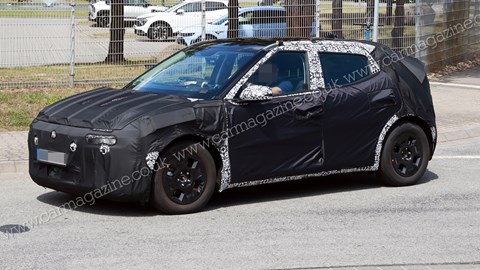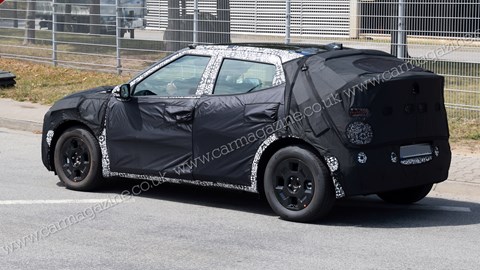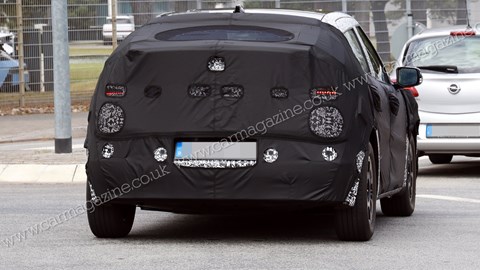► Hyundai’s next Ioniq car is incoming
► New Ioniq 2 is next up for reveal
► Concept car will be at 2025 Munich show
When a car maker has a successful model line that includes the numbers 5, 6 and 9, it’s tempting to start speculating that all the gaps will be filled sooner or later. And maybe they will. But Hyundai recently confirmed that it will be showing a small electric concept at this autumn’s Munich show, which is highly likely to turn into the production Ioniq 2 next spring. And now, we’ve got pictures of it too.
Our spy photographers have snapped the new car testing, and although it’s covered in camouflage we can see it has the familiar Ioniq-style LED lights. As we can see in the pics, it’ll be smaller than the recently launched Inster, and will share a version of the E-GMP platform already used by the 5, 6 and 9.

Expect lots of crossover with the Kia EV2 concept, another E-GMP buddy. And the new small Hyundai will be the first with Hyundai’s new software system, called Pleos.
Pleos is a much more comprehensive package than anything currently used by Hyundai, linking its powertrain, infotainment and more.
Xavier Martinet, president and CEO of Hyundai Motor Europe, said: ‘Connectivity is changing our relationship with the customer. We’re able to get data on a daily basis, not once a year. It’s the next frontier in terms of customer relationship.’
Martinet said the new car would be designed and built in Europe. Although generally Hyundai aimed for its cars to have around 80 per cent global content, and 20 per cent local, there were exceptions: ‘Don’t count on the US to help you develop a B-segment car. Some fights are not worth having.’
He added that 79 per cent of Hyundai’s European sales in 2024 were built in Turkey and the Czech Republic. That proportion will go down by the end of 2025, because Inster is built in Korea. ‘But we’re looking to have a very high percentage of European production.’
Average prices paid for Hyundais in the UK had gone up 50 per cent in the last five years, but that didn’t mean Hyundai was only interested in selling expensive cars – that figure was a reflection of the arrival of relatively expensive cars such as the 5, 6 and 9, and the reinvented Santa Fe. But the Inster and the new smaller EV showed a commitment to more affordable cars, and the combustion i10 and i20 were continuing.

He said: ‘In 50 years Hyundai has come a very long way. First of all it was about catching up, but then you realise you’re one of the leading groups, especially in EVs.’
Hyundai’s size and flexibility meant it was better able than some rivals to adapt to changes in demand and legislation – whatever was needed, a solution would be available from somewhere within the group. But he did plead for greater consistency and stability from legislators.
‘The vehicles we’ll launch in 2029: we’re making the technical decisions now. We’re making massive investments – billions.’
Given the trade war between the US and China, with tariffs and other protectionist measures being deployed by both sides, increased local content should help keep Hyundais affordable.

‘Everyone is impacted,’ Martinet told journalists in London. ‘The question is if you can react better and quicker than the others.
‘In a crisis some companies shrink, close their doors, protect what they have. We don’t – we invest. In every crisis there is an opportunity.’